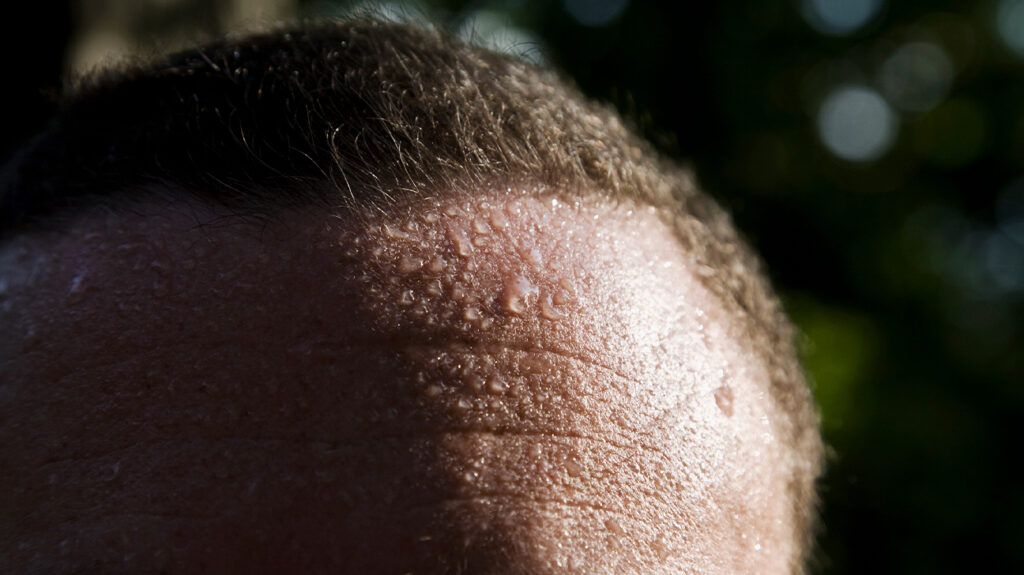Hyperhidrosis is a condition characterized by excessive sweating. Signs of hyperhidrosis include visible sweating and sweating that interferes with everyday activities. It may affect one area or the whole body.
Hyperhidrosis is also known as polyhidrosis or sudorrhea. Although not life threatening, it can be uncomfortable and cause embarrassment and psychological trauma.
This article examines the causes, symptoms, diagnosis, and treatment of hyperhidrosis.

Hyperhidrosis causes excessive sweating. People may have focal hyperhidrosis, which involves localized sweating. For example, palmoplantar hyperhidrosis is excessive sweating of the palms and soles.
Alternatively, people may have generalized hyperhidrosis, which is sweating that affects the entire body.
Hyperhidrosis is typically the
- hands
- feet
- face and head
- armpits
Hyperhidrosis may be present from birth or might develop later in life. However, most cases occur in people between the ages of 20 and 60. The condition affects around 3% of people in the United States.
A
Hyperhidrosis is sweating that disrupts normal activities. Episodes of excessive sweating
Signs and symptoms of hyperhidrosis may include:
- clammy or wet palms
- clammy or wet soles of the feet
- frequent sweating
- noticeable sweating that soaks through clothing
People with hyperhidrosis might experience irritation and skin problems linked to excessive sweating, such as fungal or bacterial infections.
They may also experience non-visible symptoms, including:
- concern about stained clothing
- reluctance to make physical contact
- feelings of self-consciousness or embarrassment
- social withdrawal
- feelings of depression or anxiety
- excessive worry about body odor
Primary idiopathic hyperhidrosis is a type of the condition that has no apparent cause. In contrast, secondary hyperhidrosis occurs due to an underlying health condition.
Causes of primary hyperhidrosis
Researchers
A
The review suggests a strong genetic basis for primary hyperhidrosis because a family history of the condition increases a person’s risk.
Further research is necessary to understand the specific cause of this condition.
Causes of secondary hyperhidrosis
Secondary hyperhidrosis may occur due to the
- medications, such as:
- antibiotics
- antidepressants
- insulin
- certain topical therapies
- systemic conditions, such as:
- certain medical procedures
- pregnancy
- menopause
- infections
- obesity
- spinal cord injuries
- heart failure
- alcohol use disorder
Initially, doctors
They may try to rule out any underlying conditions that could cause secondary hyperhidrosis by ordering certain tests, such as blood tests or imaging tests.
A visual assessment is usually enough for a doctor to diagnose a person with excessive sweating. However, in some cases, they may also request a starch-iodine test.
A doctor applies a powder to the skin that is sensitive to moisture. When excessive sweating occurs at room temperature, the powder changes color.
If a person has secondary hyperhidrosis, a doctor may prescribe treatment for the underlying cause as well as treating the symptoms of hyperhidrosis.
Doctors
Other potential treatments include:
- Iontophoresis: The person submerges their hands and feet in a bowl of water. A painless electric current passes through the water.
- Botulinum toxin (Botox injections): Botox injections block the nerves that trigger the sweat glands. Patients with hyperhidrosis may need several injections for effective results.
- Anticholinergic drugs: Anticholinergic medications inhibit the transmission of parasympathetic nerve impulses.
- Surgical techniques: Surgical interventions, such as sympathectomy, subcutaneous liposuction, or radiofrequency ablation, may be a last resort treatment if other methods do not work.
Healthcare professionals may also suggest a combination of the above treatments.
Some alterations in daily activity and lifestyle may also help to improve symptoms:
- Try antiperspirants: Deodorants do not stop sweating, but antiperspirants sprays do. Some prescription antiperspirants include aluminum chloride, which plugs the sweat glands.
- Wear armpit shields: Armpit shields are pads that people wear in the armpit to protect their clothing from perspiration.
- Consider fabric and clothing styles: Certain synthetic fibers, such as nylon, may worsen symptoms. Loose clothing may help.
- Consider shoe materials: Synthetic materials may worsen symptoms. Natural materials, such as leather, may help to reduce symptoms.
- Try different socks: Similarly some socks are better at absorbing moisture, such as thick, soft ones made of natural fibers.
- Avoid triggers: If things such as alcohol or spicy food worsen symptoms, it can help to avoid or limit them.
If these measures are not effective, medical treatment may help.
A person with untreated hyperhidrosis may experience the following complications:
skin infections , such as athlete’s footemotional or psychological distress - dehydration
- warts
- skin conditions, such as eczema and psoriasis
Hyperhidrosis symptoms and complications can affect a person’s quality of life. Seeking treatment can help affected people manage their condition.
Hyperhidrosis is a condition that involves excessive sweating. This may affect a person’s entire body or only one area, such as the palms of the hands.
In some cases, hyperhidrosis may occur due to an underlying health condition. However, there may also be a genetic component.
People can speak with a healthcare professional about treatments for hyperhidrosis. This may include medications, Botox injections, or lifestyle changes.
